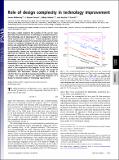| dc.contributor.author | McNerney, James M. | |
| dc.contributor.author | Farmer, J. Doyne | |
| dc.contributor.author | Redner, Sidney | |
| dc.contributor.author | Trancik, Jessika E. | |
| dc.date.accessioned | 2011-12-05T21:40:42Z | |
| dc.date.available | 2011-12-05T21:40:42Z | |
| dc.date.issued | 2011-05 | |
| dc.date.submitted | 2010-11 | |
| dc.identifier.issn | 0027-8424 | |
| dc.identifier.issn | 1091-6490 | |
| dc.identifier.uri | http://hdl.handle.net/1721.1/67448 | |
| dc.description.abstract | We study a simple model for the evolution of the cost (or more generally the performance) of a technology or production process. The technology can be decomposed into n components, each of which interacts with a cluster of d - 1 other components. Innovation occurs through a series of trial-and-error events, each of which consists of randomly changing the cost of each component in a cluster, and accepting the changes only if the total cost of the cluster is lowered. We show that the relationship between the cost of the whole technology and the number of innovation attempts is asymptotically a power law, matching the functional form often observed for empirical data. The exponent α of the power law depends on the intrinsic difficulty of finding better components, and on what we term the design complexity: the more complex the design, the slower the rate of improvement. Letting d as defined above be the connectivity, in the special case in which the connectivity is constant, the design complexity is simply the connectivity. When the connectivity varies, bottlenecks can arise in which a few components limit progress. In this case the design complexity depends on the details of the design. The number of bottlenecks also determines whether progress is steady, or whether there are periods of stasis punctuated by occasional large changes. Our model connects the engineering properties of a design to historical studies of technology improvement. | en_US |
| dc.description.sponsorship | National Science Foundation (U.S.) (Grant SBE0738187) | en_US |
| dc.description.sponsorship | National Science Foundation (U.S.) (Grant DMR0535503) | en_US |
| dc.language.iso | en_US | |
| dc.publisher | National Academy of Sciences (U.S.) | en_US |
| dc.relation.isversionof | http://dx.doi.org/10.1073/pnas.1017298108 | en_US |
| dc.rights | Article is made available in accordance with the publisher's policy and may be subject to US copyright law. Please refer to the publisher's site for terms of use. | en_US |
| dc.source | PNAS | en_US |
| dc.title | The Role of Design Complexity in Technology Improvement | en_US |
| dc.type | Article | en_US |
| dc.identifier.citation | McNerney, J. et al. “Role of design complexity in technology improvement.” Proceedings of the National Academy of Sciences 108.22 (2011): 9008-9013. | en_US |
| dc.contributor.department | Massachusetts Institute of Technology. Engineering Systems Division | en_US |
| dc.contributor.approver | Trancik, Jessika E. | |
| dc.contributor.mitauthor | Trancik, Jessika E. | |
| dc.relation.journal | Proceedings of the National Academy of Sciences of the United States of America | en_US |
| dc.eprint.version | Final published version | en_US |
| dc.type.uri | http://purl.org/eprint/type/JournalArticle | en_US |
| eprint.status | http://purl.org/eprint/status/PeerReviewed | en_US |
| dspace.orderedauthors | McNerney, J.; Farmer, J. D.; Redner, S.; Trancik, J. E. | en |
| dc.identifier.orcid | https://orcid.org/0000-0001-6305-2105 | |
| dspace.mitauthor.error | true | |
| mit.license | PUBLISHER_POLICY | en_US |
| mit.metadata.status | Complete | |
